JCB Hydraulic Excavators JS130W, JS145W, JS150W, JS160W, JS175W Factory Service & Shop Manual
Catalog:
Model:
Complete workshop & service manual with electrical wiring diagrams for JCB Hydraulic Excavators JS130W, JS145W, JS150W, JS160W, JS175W. It's the same service manual used by dealers that guaranteed to be fully functional and intact without any missing page.
This JCB Hydraulic Excavators JS130W, JS145W, JS150W, JS160W, JS175W service & repair manual (including maintenance, overhaul, disassembling & assembling, adjustment, tune-up, operation, inspecting, diagnostic & troubleshooting…) is divided into different sections. Each section covers a specific component or system with detailed illustrations. A table of contents is placed at the beginning of each section. Pages are easily found by category, and each page is expandable for great detail. The printer-ready PDF documents work like a charm on all kinds of devices.
FILELIST:
9803-6300 - JCB Hydraulic Excavators JS130W, JS150W Service Manual.pdf
9803-6310 - JCB Hydraulic Excavators JS130W, JS145W, JS160W, JS175W Service Manual.pdf
9803-6550 - JCB Hydraulic Excavators JS175W Auto Service Manual.pdf
9803-6590 - JCB Hydraulic Excavators JS130W, JS145W, JS160W, JS175W Service Manual.pdf
9813-1700 - JCB Tracked Excavators JS Auto Range JS145W-JS160W & Variants (JCB Engine) Service Manual.pdf
EXCERPT:
Service Manual
JS Auto Range - Wheeled Excavators -
JCB Engine
Section 1 - General Information
Section 2 - Care & Safety
Section 3 - Maintenance
Section B - Body & Framework
Section C - Electrics
Section D - Controls
Section E - Hydraulics
Section F - Transmission
Section K - Engine
...
Section E - Hydraulics
Drive Motor
Operation
Fig 1. Operation below 210bar
Fig 2. Operation at high pressure - 220bar
Under normal non-inclined road conditions, oil enters at ports A and B (depending on the drive direction). At port A, oil pressure moves the shuttle and oil flows at system pressure to act on the threshold piston. The oil is allowed to pass through the motor and back to tank.
Oil is available to the brake spool section. The flow is deadended at a check valve, but is available at the spool end, where it selects a spool. Oil passes through the other check valve, where it is dead-ended by the selected spool.
When the machine encounters an incline however, the operation changes. Oil still flows through the motor but, as the pressure starts to build up from the effect of the incline, this pressure starts to be felt at CV1 which allows oil to pass, at CV2, which closes off, the supply to the filter, through the orifice, across the spool to a, Max speed /Min Flow side of the piston. The piston holds Max speed.
The pressure is felt at the spool end, but the spool does not select as the spring pressure holds it stationary. Oil from the other side of the piston is open to tank. As the pressure rises to match and overcome the spring pressure (threshold pressure), the spool will start to select.
The oil flow across the spool changes direction to feed the b Min speed/Max flow side of the piston, this moving the piston in the opposite direction altering the swash angle to give maximum torque. The max side of the piston is then open to tank. The spool shuttles to match torque with road conditions.
When the machine travels down hill, the motor operation acts as a pump, the oil supply is insufficient to prevent cavitation within the motor. Negative pressure can lift the check valve and allow oil from tank to make up and prevent cavitation.The restrictions within the brake spool give the motor its braking effect by slowing the oil as it returns to tank.
Ports on Motor Body
...





